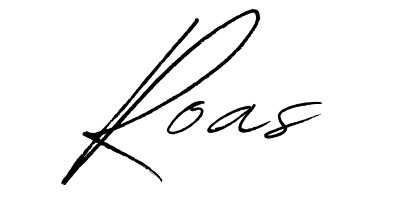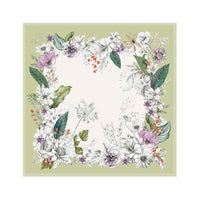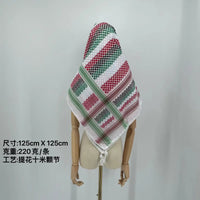Introduction: Why choose circular weft knitted scarves?
Dear customers, hello!
When you consider customizing scarves, you may encounter various process options, such as weaving, flat knitting, circular weft knitting, etc. Today, we will focus on circular weft knitted scarves - this process has become the first choice for many brands and companies due to its high efficiency, softness, and good elasticity.
But what exactly is circular weft knitting? Is it suitable for your needs? What key points should be paid attention to during the customization process? This blog will give you a comprehensive understanding and help you make a more informed decision.
Have you ever knitted scarves before? Do you value the comfort, cost, or design flexibility of scarves more? Feel free to think about these questions while reading!
Circular weft knitting process: basic cognition
What is circular weft knitting?
Circular weft knitting is a knitting technology that uses a circular knitting machine (circular machine) to weave yarns in a loop along the weft (cross direction) to form a tubular fabric, which is then cut and sewn into a scarf.
The circular knitting machine is mainly composed of a yarn feeding mechanism, a weaving mechanism, a pulling-winding mechanism and a transmission mechanism. The function of the yarn feeding mechanism is to unwind the yarn from the bobbin and transport it to the weaving area. It is divided into three types: passive, active and storage.
Features comparison:
- Compared with woven scarves: softer, more elastic, suitable for close-fitting wear.
- Compared with flat knitting: higher production efficiency, suitable for large-volume orders, but the complexity of the pattern is slightly lower.
Advantages and disadvantages of circular knitting scarves
✅ Advantages:
- High production efficiency: suitable for medium to large orders (more than 1,000 pieces) and short delivery cycle.
- Soft and elastic: suitable for keeping warm in autumn and winter, comfortable to wear.
- Controllable cost: more competitive unit price than manual or flat knitting.
❌ Limitations:
- Simpler pattern: complex jacquard or three-dimensional texture is difficult to achieve (but can be compensated by printing).
- Need to cut and sew: The circular knitting machine produces tubular fabrics, which need to be processed later. Edge processing affects the aesthetics.
Finished product inspection
defect detection:
- Holes/missing stitches (transparent inspection table)
- Color difference (standard light box comparison)
- Dimension tolerance (length ±1.5cm, width +0.5cm)
Physical property test:
Stretch elastic recovery rate>85% (horizontal)
Water washing shrinkage rate≤3%Pure cotton needs pre-shrinkage
Does your scarf need a complex pattern? Or do you focus more on mass production of basic models?
Key considerations for custom circular knitted scarves
Yarn selection: determines the texture of the scarf
The yarn material directly affects the feel, warmth and price of the scarf:
- Natural fibers: cotton (breathable), wool/cashmere (warm and high-end), silk (glossy and smooth).
- Synthetic fibers: polyester (durable, low cost), acrylic (imitation wool feel), viscose (good drape).
- Blended: such as cotton + polyester (balance comfort and wrinkle resistance), wool + nylon (enhanced wear resistance).
If you are looking for cost-effectiveness, blended is a good choice; high-end gift scarves can choose cashmere or silk.
Weight and size: How to balance practicality and cost?
- Weight (weight of fabric per square meter):
- Thin (120-180g/㎡): suitable for spring and autumn or decorative purposes.
- Thick (200-300g/㎡): the first choice for winter warmth.
- Size: Common width 20-30cm, length 120-180cm, can be customized freely.
Do you want the scarf to be thin and versatile, or thick and warm?
Color and pattern: How to realize your design?
- Plain color: Circular knitting can easily achieve solid color, rich and uniform color.
- Stripes/simple jacquard: horizontal stripes or geometric patterns are achieved through yarn replacement technology.
- Printing: If you need complex patterns (such as logos, gradients), you can use digital printing after weaving.
When designing, you need to consider whether the yarn color is sufficient. Small customization may require the cost of dyeing yarn.
Finishing process: Improve the quality of scarves
- Raising/brushing: Make the surface fluffy and soft (commonly used for cashmere or cashmere-like scarves).
- Anti-pilling treatment: Improve durability, especially for wool blended products.
- Antistatic: A must for chemical fiber scarves
- Washing and aging: Give scarves a retro texture.
- Antibacterial finishing: Medical/baby use
Typical application scenarios of circular knitted scarves
What is the purpose of your scarf? Different scenarios have different process requirements:
1. Corporate gifts: Focus on logo presentation, it is recommended to choose solid color + embroidery/printing.
2. Fashion brands: Focus on design, you can try blended materials + striped jacquard.
3. Promotional gifts: Prioritize cost, polyester or cotton blends are good choices.
Case sharing: A coffee brand customized 5,000 circular knitted scarves, using recycled polyester yarn + environmentally friendly printing, with a cost control of 15 yuan/piece, and it is very popular as a member gift!
Customization process: steps from demand to finished product
1. Demand communication: material, size, color, quantity, and purpose.
2. Proofing confirmation: provide samples (usually a proofing fee is required, which can be deducted for large quantities).
3. Production and quality inspection: mass production (cycle is about 15-30 days, depending on the quantity).
4. Delivery: support trade terms such as FOB or EXW.
Be sure to confirm the sample details (such as stitching, label position) to avoid deviations in large quantities!
Frequently Asked Questions (Q&A)
Q1: Does circular knitted scarves pill?
A: Slight pilling of natural fibers (such as wool) is normal, which can be improved by blending or anti-pilling processes.
Q2: What is the minimum order quantity (MOQ)?
A: Usually 200 pieces or more, depending on the yarn and process complexity.
Q3: How to control costs?
A: Choosing ordinary yarn, reducing the number of colors, and increasing the order quantity can all reduce the unit price.
Conclusion: Your scarf, we create together
I hope that through this guide, you will have a clearer understanding of circular knitted scarves. We are a professional scarf manufacturer with 10 years of circular knitting experience and an 8-acre factory. We control the entire process from yarn procurement to finished product delivery to help you efficiently implement customized needs.

Next steps:
1. Tell us your scarf concept (material/quantity/design).
2. Get a quote and solution.
Looking forward to working with you to create a unique scarf product!
Do you have any questions about scarf customization? Welcome to leave a message or directly consult our customer service!













